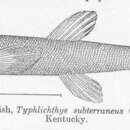en
names in breadcrumbs


Southern cavefish are well-adapted for their environment. Low growth and metabolic rates as well as eye degeneration and pigment loss decrease the amounts of expended energy; parental care of young increases their chances of survival; and a well-developed sensory papillae network and spatial memory aids in navigation.
It has been suggested that the extent of eye and pigment degeneration may be a reflection of the length of isolation in caves and thus would be a helpful tool in determining the ancestral phylogenies of Typhlichthys subterraneus and other species within the family Ambloypsidae.
Southern cavefish use touch and their thigmotaxic sense to maintain their position in the water column. Their use their sense of touch extensively to detect prey. Other sensory modalities are possible, but are unknown currently.
Perception Channels: tactile ; chemical
Because the habitat of southern cavefish is so unique and because population numbers are normally low, they are regarded as a vulnerable species. Any amount of habitat that is destroyed or altered would have a significant impact. However, many of the cave systems inhabited by Typhlichthys subterraneus are protected by govenmental regulation (e.g., Mammoth Cave in Kentucky).
US Federal List: no special status
IUCN Red List of Threatened Species: vulnerable
Eggs are held in the gills of females until they hatch. Otherwise, little is known of development in southern cavefish.
There are no adverse effects of southern cavefish for humans.
Southern cavefish are important members of their ecosystems and important research subjects for understanding evolution in extreme environments.
Positive Impacts: research and education
These animals are the top predators in the environments in which they live.
Food is scarce. Typhlichthys subterraneus forages using its sensory papillae in midwater and on the substrate. When prey is within 10 mm of the mouth, capture movements are commenced. Southern cavefish have distance perception and spatial memory which aid in foraging behavior. Their diet consists mainly of copepods (60-90%, by volume).
Foods eaten include trichopteran larvae, tendepedid larvae, cladocerans, isopods, crayfish, and copepods.
Animal Foods: insects; aquatic crustaceans
Primary Diet: carnivore (Eats non-insect arthropods)
Typhlichthys subterraneus is restricted in its geographic range to the North American continent. Some scientists believe their range was continuous in the past and may still be, but it is difficult to determine. Many scientists agree the range is now disjunct, with species inhabiting specific cave systems in Tennessee, Alabama, Missouri, Arkansas, Oklahoma, and Kentucky, but always south of the limit of glaciation. Dispersal is presumed to be through underground water channels.
Biogeographic Regions: nearctic (Native )
Southern cavefish inhabit subterranean waters and are troglobitic. They prefer caves that are near the watertable and have low energy flows. These caves have water temperatures of 10 to 15 degrees C. Southern cavefish have adapted to life in an extreme habitat that includes factors such as low food supply, seasonal water level changes, and an aphotic environment.
Habitat Regions: temperate
The expected life span is four years in the wild.
Typical lifespan
Status: wild: 4.00 (high) years.
Average lifespan
Status: captivity: 4 years.
Typhlichthys subterraneus is a small fish reaching a maximum length of 9 centimeters. Individuals have large broad heads with rudimentary eyes hidden under the skin. Normally there is no pigment on the body, although tests have shown that coloration does appear if a specimen is removed from its habitat and exposed to light. Southern cavefish do not have pelvic fins. There are 7-10 dorsal rays, 7-10 anal rays, and 10-15 caudal rays. The body, head, and caudal fin is covered by sensory papillae.
Range length: 9.0 (high) cm.
Average length: 8.6 cm.
Other Physical Features: ectothermic ; heterothermic ; bilateral symmetry
There are no known predators of southern cavefish.
There is little known of mating behavior in southern cavefish.
Breeding is presumed to occur in the spring season when, unfortunately, the caves are inaccessible due to high water levels.The rise in the water table drives a temperature and alkalinity decrease and also results in an increase in food availability. In response to such stimuli, a hormone is released and the gonads complete their maturation. Females are low in fecundity, producing an average of 49 eggs per female that range from 2.0-2.3 millimeters in size. It is estimated that 50% of adult females breed each year. Because of this, population sizes are small, and as a result, mates are difficult to find. Therefore, a great amount of energy is put into the rearing of young.
Breeding interval: Breeding occurs each year.
Breeding season: Breeding is thought to occur in spring.
Average number of offspring: 49.
Range age at sexual or reproductive maturity (female): 2.0 (high) years.
Range age at sexual or reproductive maturity (male): 2.0 (high) years.
Key Reproductive Features: iteroparous ; seasonal breeding ; sexual
Eggs are incubated in the gill chambers of the parent female for an unspecified amount of time. Fry have been recorded in June and July.
Parental Investment: pre-fertilization (Provisioning, Protecting: Female); pre-hatching/birth (Provisioning: Female, Protecting: Female)